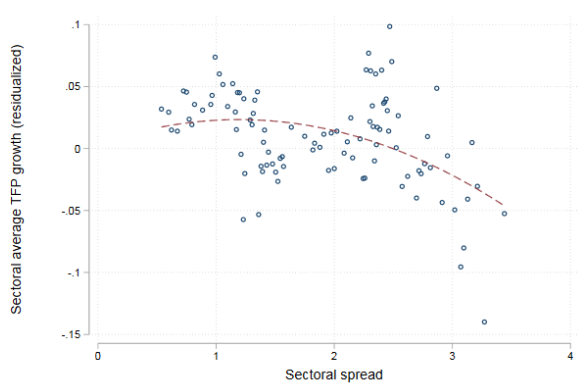Rising credit constraints are usually shown to have a direct detrimental effect on productivity growth. By increasing the cost of financing, they make it more difficult to invest in R&D. This channel is overlooked, for example, by Aghion et al. (2012) and is surveyed by Popov (2017). In the context of the Global Crisis, many recent empirical papers have leveraged firm-level datasets to obtain similar results in many different countries. For instance, Duval et al. (2017), Besley et al. (2018) and Manaresi and Pierri (2017) all showed that higher financial constraints around the time of the crisis had an overall negative impact on productivity growth for US, UK, and Italian firms respectively. In particular, the firms that are the most exposed to financial constraints are shown to lower their investments, especially in R&D, ICT, or intangible capital, which are all assets with a potentially strong long-run impact on productivity.
Two opposite channels through which credit constraints impact productivity growth
However, perhaps less intuitively, rising financial constraints can also have a positive effect on aggregate economic productivity. This second channel is the consequence of production factors’ misallocation – a relaxation of credit constraints reduces the mechanism through which the less productive firms exit the market (cleansing). Such firms are then able to survive, which increases the entry cost of new, potentially more efficient innovators. In its most extreme form, this mechanism can lead to the phenomenon of zombie firms, whereby the surviving incumbent firms are below the profitability threshold, which in turn is derived from the level of interest rates. Caballero et al. (2008) show how a combination of prudential regulations and bad banking credit policy resulted in maintaining the life of zombie firms thanks to credit evergreening. This created congestion in some sectors, which in turn reduced the profits of healthy firms and discouraged entry and investment. A recent empirical literature has argued that this mechanism could have been at play before the Crisis. The low real interest rates and easy credit access that prevailed at this time might have partly explained the productivity slowdown experienced in developed countries, especially in southern Europe over the past period (Gopinath et al. 2017, Reis 2013, Cette et al. 2016).
The inverted-U relationship
In a new paper (Aghion et al. 2019), we develop a simple theoretical model of firm dynamics and innovation-led growth with credit constraints, to reconcile formally the two channels highligthed above. The model shows that, under suitable conditions, these two opposite effects generate an inverted-U relationship between credit access to incumbent firms and productivity growth. In other words, tightening credit constraints has a negative impact on productivity growth, up to a certain level. Beyond this level, tightening credit constraints further results in an improvement in the factors allocation mechanism and, overall, leads to an acceleration in productivity.
We confront this theoretical prediction with the data and confirm empirically the coexistence of the two channels using information on French manufacturing firms. Our empirical strategy relies on a rich dataset built by the Banque de France, which provides both standard accounting information (balance sheet and income statement) and information on an additional variable called “Cotation”, which rates firms according to their financial strength and capacity to meet their financial commitments. This rating is updated every year and has been shown to be a good proxy for firms’ credit access and financial costs as it is widely used by banks when deciding whether and how much credit to grant to firms. It is also considered by the ECB and more generally the Eurosystem, when assessing whether a bank's credit to a given firm can be pledged as collateral against central bank refinancing.
With this dataset, we would like to test the two opposite effects of credit access by incumbent firms on productivity. One difficulty is that the overall effect results from two different channels. The negative ‘investment’ effect of tighter credit access is channeled through innovative firms, while the positive ‘reallocation’ effect of tighter credit access comes from the entry and exit of firms. To get a complete picture, we therefore first aggregate growth and credit at the sectoral level. We regress sectoral productivity growth on a sectoral measure of credit constraint – namely, the difference between the average rate of new loans to firms in the sector and a reference rate, controlling for sector-fixed effects. Figure 1 shows some evidence on an inverted-U relationship between credit constraints and productivity growth.
Figure 1 Sectoral interest rate spread and TFP growth
Note: Each dot represents a sector in a specific year from 2006 to 2016. TFP growth and spread (the difference between average rate of new loans by manufacturing firms in France and the average EONIA) have been residualised on a sector-fixed effect.
Turning to the firm-level analysis, we perform two separate exercises. We first show that firms that experience an increase in their rating are positively impacted in their future productivity performance. We then use a survival model to show that a better rating is also associated with a lower exit rates, particularly for the least productive firms.The latter result suggests that easier credit access allows low productivity firms to remain in the market, which in turn has a detrimental effect on aggregate productivity.
To deal with potential endogeneity issues, we exploit a policy change that improved credit access for only a subset of incumbent firms at specific time. The 2012 Eurosystem's Additional Credit Claims (ACC) programme extended the set of loans eligible for banks' refinancing with the Eurosystem. The programme extended the eligibility criteria to include a specific group of French firms from February 2012 onwards (Bignon et al. 2016). For the treated firms, this corresponds to a positive shock in credit access, especially when compared to a control group composed of firms just below the eligibility threshold. Exploiting this discontinuity confirms all our results, namely that incumbent firms directly affected by this ACC programme experienced an upward jump in productivity growth post-ACC. We also show that these treated firms experienced lower exit rates, particularly those that were the least productive before the introduction of the ACC programme.
Implication for the debate on secular stagnation
An extension of the above analysis would be to assess the implications of this inverted-U relationship for the conduct of fiscal and monetary policy over the business cycle. Our analysis points to a potentially negative growth effect of maintaining low interest rates in good times.
Our paper also has implications for the debate on secular stagnation. The decline in productivity growth in most advanced countries since the 1970s may indeed be partly related to overall easier access to credit due to financial liberalisation over the period. This possibility has been raised by other authors, for example by Liu et al. (2019). However, these authors emphasise a different mechanism, namely that in their model lower interest rates enhance the innovation incentives of technological leaders in the various sectors of the economy. This in turn increases the average technological gap between leaders and followers, and consequently discourages innovation by followers. Instead, our own analysis points at the negative reallocation effect of lower interest rates that ease the credit constraints faced by incumbent firms. Our analysis suggests that financial and corporate regulations, for example insolvency laws, have a major role to play in channelling capital towards the most promising firms rather than to weakly efficient incumbents.
A positive technological shock stemming from the digital economy could take place in the future (e.g. Brynjolfsson and McAfee 2014). It could have a large positive impact on productivity and growth, which would drive up interest rates. This upward effect on real interest rates would reinforce the positive productivity impact through the cleansing mechanism, which would improve production factor allocation.
References
Aghion, P, P Askenazy, N Berman, G Cette, and L Eymard (2012), “Credit constraints and the cyclicality of R&D investment: evidence from France”, Journal of the European Economic Association, 10, 1001-24.
Aghion, P, A Bergeaud, G Cette, R Lecat, and H Maghin (2019), “The Inverted‐U Relationship Between Credit Access and Productivity Growth”, Economica, 86, 1-31.
Besley, T, I Roland, and J Van Reenen (2018), “The aggregate effects of credit market frictions: evidence from firm-level default assessments”, Technical Report, mimeo.
Bignon, V, F Boissay, C Cahn, and L-M Harpedanne de Belleville (2016), “Extended eligibility of credit claims for Eurosystem refinancing: consequences for the supply of credit to companies”, Quarterly Selection of Articles, Banque de France, no. 43, 15-23.
Brynjolfsson, E, and A McAfee (2014), The Second Machine Age: Work, Progress, and Prosperity in a Time of Brilliant Technologies, W W Norton.
Caballero, R J, T Hoshi, and A K Kashyap (2008), “Zombie lending and depressed restructuring in Japan”, American Economic Review, 98, 1943-77.
Cette, G, J Fernald, and B Mojon (2016), “The pre-Great Recession slowdown in productivity”, European Economic Review, 88, 3-20.
Duval, R, G Hong, and Y Timmer (2017), “Financial frictions and the great productivity slowdown”, IMF Working Paper no. 17/129.
Gopinath, G, S Kalemli-Özcan, L Karabarbounis, and C Villegas-Sanchez (2017), “Capital allocation and productivity in South Europe”, Quarterly Journal of Economics, 132, 1915-67.
Liu, E, A Mian, and A Sufi (2019), “Low Interest Rates, Market Power, and Productivity Growth”, NBER Working Paper no. 25505.
Manaresi, F, and N Pierri (2017), “Credit constraints and firm productivity: evidence from Italy”, Working Paper no. 137, Money and Finance Research Group, Marche Polytechnic University.
Popov, A (2017), “Evidence on finance and economic growth”, ECB Working Paper no. 2115.
Reis, R (2013), “The Portuguese slump and crash and the euro crisis”, Brookings Papers on Economic Activity, 44,143-210.









